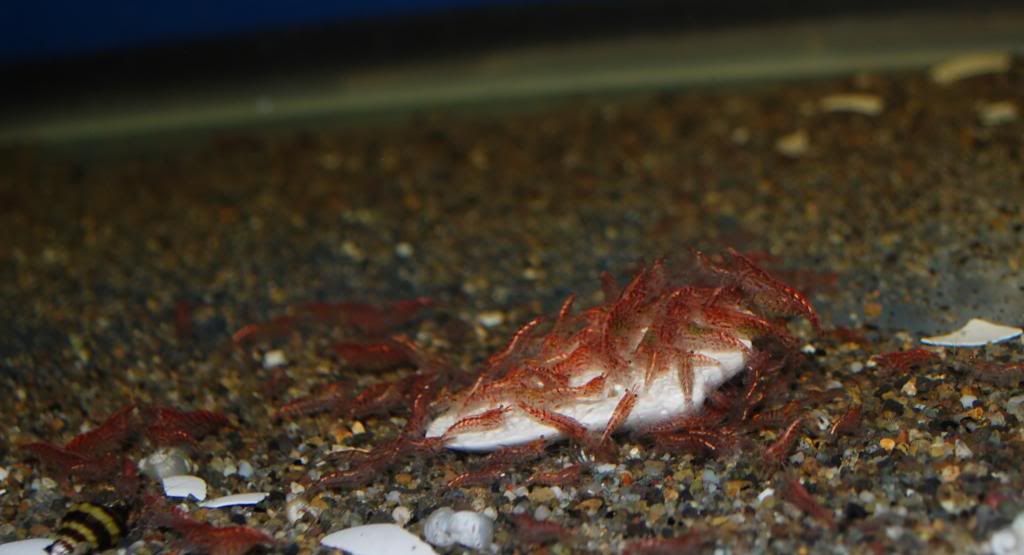Neocaridina Heteropoda variation red, commonly known as Cherry Shrimp have been bred from Taiwan. Wild Neocaridina Heteropoda does not have any distinctive colours and is a mix of opaque brown with a tint of green. Wild Neocaridina Heteropoda live in various areas, but were discovered in rice paddies. This environment have been said to be where they evolved to have a characteristic to withstand high nitrates. Through selective breeding, the red variety was achieved, however this meant greater sensitivity to water quality. The variation of the red variety can be easily found in most local aquariums. Depending on how solid and deep the red is on the shrimp, will determine its grade. The grade is known through their common names (e.g. Cherry, Sakura, Fire Reds, and Painted Fire Reds).

Basic Care:
Cherry Shrimps are generally an easy shrimp to care for. Like most invertebrates, avoid feeding foods that have copper sulphate, as they are highly sensitive to it. Studies are currently being done on copper sulphate and their effects on invertebrates. Although a small amount is deemed safe to shrimps, as it helps their circulation, I recommend avoiding it, because the copper will eventually accumulate to unsafe levels. Copper sulphate can be found in aquarium medication, food and fertilizers. There are shrimp safe fertilizers for planted aquariums, be sure to read the ingredient make up. They are very prolific in their breeding and can adapt to a large range on water conditions. Generally, they should be kept in the following:
pH: 6.5 – 8
Temperature: 14-30°C (57-86°F)
Tank Size: 4-8 litres (0.88 – 1.1-2.1 US gallons)
NH3: 0 ppm
NO2: 0 ppm
NO3: Less than 20 ppm
I have been able to keep them in an unfiltered tank with only duckweed and a sand substrate with 1 litre of water, in which they still breed [note: the colour of the substrate will affect their colouration]. In order to get the most colouration from these shrimp, it’s recommended to use a dark substrate. Colouration intensity depends on the food type available, water quality and temperature. I have found food high in protein and carotenoids have been able to increase in red intensity to a large degree.
The shrimps will spend most of their time scavenging for food, and hiding from predators. Most shrimp enthusiasts will recommend a shrimp only tank, as most fish can’t resist pecking and eating these guys. Baby shrimps are so small that they are food to even the smallest fish. That being said, I have successfully kept cherry shrimp in a planted goldfish tank given enough hiding places. Using tough plants like anubias, they’re able to hide away from the goldfish. The main difficulty in keeping them in the goldfish tank is to ensure water quality, as nitrates increase quickly.
Behaviour:
They are non-aggressive shrimps, and are usually very active, especially males when females are ready to mate. Mating has been found to be related to pressure change in the atmosphere caused by rainfall. There are certain situations that usually cause the shrimps to hide, such as, when there are predators in the tank, when they sheds their exoskeleton, and when female shrimps are "berried" (have eggs under their swimming legs). Water changes will cause them to molt (moult) their exoskeleton, which when done excessively in large amounts could cause a force moult. A forced moult is when the shrimp is not ready to moult their exoskeleton safely, but does so anyways. This could result in unsuccessful moults, and sadly resulting in death. I advise add calcium sulphate or calcium magnesium to aquariums, following the label of the product. Studies have found that calcium sulphate of 22% have been very successful in increasing the quality of invertebrates exoskeleton.You can use calcium blocks are shown below.
Breeding the shrimp is fairly easy, just have patience and ensure quality water and low nitrates. They are live bearing shrimps, and will carry the eggs until they hatch. s The females will fan the eggs with their swimming legs (pleopods), which helps the eggs mature. One female shrimp carries, on average, 20-30 eggs, which takes about 3 weeks to hatch. They hatch at miniature version of the adult shrimps, meaning no larval stage. They will require bio-film on the plants or on a sponge filter to develop. In my goldfish tank, I have two sponge filter and a pre-sponge filter on the tank allowing for many areas for shrimps to feed. In a mature tank, it’s very unlikely for a shrimp to die due to starvation, feeding is often used to help speed up growth and colouration. Over feeding is known to cause death by polluting the water, thus, never feed more than what the shrimp can finish in 2-3 hours. In my fully planted shrimp tanks, I feed them once every 2 weeks, sometimes 3 weeks and they are multiplying like crazy. Baby shrimps are highly sensitive to nitrates, even more so than the adult shrimps. Thus, if your adult shrimps are fine, but the baby shrimps are dying, check your nitrates!
Sexing:



Quick tips in keeping shrimp
1. Avoid using water, food, medication, fertilizers that contain copper sulphate
2. Add calcium blocks, but in moderation to not go pass the point of 22% concentration
3. Avoid over feeding your shrimps. If preferred to feed every day, don’t give food at least one day of the week.
4. Perform small water changes once a week (at most 20%)
5. Use sponge filters and plants with lots of bio-film
6. Foods containing carotenoids and substrate that is dark will help improve colouration
- ASC


No comments:
Post a Comment